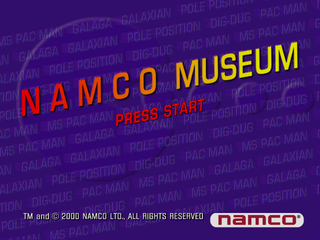Namco Museum
From Sega Retro
| Namco Museum | ||||||||||
|---|---|---|---|---|---|---|---|---|---|---|
| System(s): Sega Dreamcast | ||||||||||
| Publisher: Namco Hometek | ||||||||||
| Developer: Mass Media | ||||||||||
| Original system(s): Arcade boards | ||||||||||
| Developer(s) of original games: Namco | ||||||||||
| Game total: 6 | ||||||||||
| Peripherals supported: Dreamcast Arcade Stick, Jump Pack, Visual Memory Unit, Dreamcast VGA Box | ||||||||||
| Genre: Compilation | ||||||||||
| Number of players: 1-2 (alternating) | ||||||||||
| ||||||||||
|
This short article is in need of work. You can help Sega Retro by adding to it.
Namco Museum is a North America-exclusive compilation of six classic Namco arcade games for the Sega Dreamcast. Players choose the various titles from the main menu, use ![]() to insert credits into each game, and the directional pad and
to insert credits into each game, and the directional pad and ![]() for controls.
for controls.
Contents
Games included
| Pac-Man (1980) | |
|---|---|
| The player controls Pac-Man through a maze, eating pac-dots. When all dots are eaten, Pac-Man is taken to the next stage. Four ghosts (Blinky, Pinky, Inky and Clyde) roam the maze, trying to catch Pac-Man. If a ghost touches Pac-Man, a life is lost. When all lives have been lost, the game ends. Pac-Man is awarded a single bonus life at 10,000 points by default. | |
| Ms. Pac-Man (1981) | |
| The gameplay of Ms. Pac-Man is largely identical to that of the original Pac-Man. The player gathers points by eating dots and avoiding ghosts. Power-pellets or energizers change the ghosts, which reverse their course and can be eaten for bonus points. Fruit bonuses can be consumed for increasing point values, twice per level. As the levels increase, the speed and difficulty increase as well. | |
| Dig Dug (1982) | |
| The objective of Dig Dug is to destroy underground monsters. This can be done by inflating them until they pop or by dropping rocks on them. There are two kinds of enemies: Pookas, round red monsters who wear yellow goggles, and Fygars, green dragons who can breathe fire. The player's character is Dig Dug, dressed in white and blue, and able to dig tunnels. | |
| Galaxian (1979) | |
| Galaxian features a horde of attacking aliens that exchanged shots with the player. The game adds an element of drama by having the aliens periodically make kamikaze-like dives at the player's ship, the Galaxip. The game's plot consisted of a title screen that displayed the message "WE ARE THE GALAXIANS / MISSION: DESTROY ALIENS". | |
| Galaga (1981) | |
| The objective of Galaga is to score as many points as possible by destroying insect-like enemies. The player controls a fighter spaceship that can move left and right along the bottom of the playfield. Enemies fly in groups into a formation near the top of the screen, then begin flying down toward the player, firing bombs at and attempting to collide with the fighter. | |
| Pole Position | |
| In this game, the player controls a Formula One race car. The player completes a time trial lap within a certain amount of time to qualify for an F1 race at the Fuji Racetrack. After qualifying, the player race against other cars in a championship race. The game popularized the use of sprite-based, pseudo-3D graphics with its "rear-view racer format." |
Production credits
Namco Hometek Inc
- Vice President of R+D: Jesse Taylor
- Producer: Ed Woolf
- Product Marketing Manager: Jim Atkiss
- Associate Producer: Paul Guirao
- Manual Design: Price Design Team
- Quality Assurance: James Guirao, Edward Chennault, Scott Hill, Corey Rutherford, Ryan Chennault, Eric Coker
- Senior Executive Producer: Masaya Nakamura
Mass Media
- Executive Producer: David Todd
- Producer: Mark Harwood
- Conversion Producer: Bernard Whang
- Lead Programmer: Ken Jordan
- Conversion Programmer: Andy Green
- Shell/Music + SFX Programmer: Nigel Spencer
- Additional Programming: David Todd
- Lead Artist: Robin Karlsson
- Conversion Artist: Michelle Yegros-Mullet
- Software Tools Guru: Ken Jordan
- Additional Tools: Dan Pinal
- Music: Jim Andron
- Interactive Studio Management: Robert Jacob, Clyde Grossman, Stewart Kosoy
Magazine articles
- Main article: Namco Museum/Magazine articles.
Physical scans
| Sega Retro Average | |||||||||||||||||||||||||||||
|---|---|---|---|---|---|---|---|---|---|---|---|---|---|---|---|---|---|---|---|---|---|---|---|---|---|---|---|---|---|
|
| 46 | |
|---|---|
| Based on 5 reviews | |
Technical information
- Main article: Namco Museum/Technical information.
References
- ↑ http://www.gexpress.com/detailedspecs.cfm?returndept=DC&returnpage=2&number=722674021012 (Wayback Machine: 2002-03-21 00:55)
- ↑ Ação Games, "Outubro 2000" (BR; 2000-xx-xx), page 51
- ↑ Gamers' Republic, "August 2000" (US; 2000-xx-xx), page 74
- ↑ Mega Fun, "10/2000" (DE; 2000-09-06), page 65
- ↑ Neo Plus, "Wrzesień 2000" (PL; 2000-xx-xx), page 86
- ↑ Sega Magazin, "October 2000" (DE; 2000-09-04), page 22
| Namco Museum | |
|---|---|
|
Main page | Comparisons | Hidden content | Magazine articles | Reception | Technical information
Prototypes: 2000-06-07
| |
Categories:
- Dreamcast Arcade Stick-compatible games
- Jump Pack-compatible games
- Dreamcast VGA Box-compatible games
- Visual Memory Unit-compatible games
- 1-2 player games
- US Dreamcast games
- All US games
- Dreamcast games
- 2000 Dreamcast games
- All 2000 games
- Dreamcast game compilations
- All game compilations
- Dreamcast games containing VMU mini-games
- All games
- Stubs
- Credits without source
- Credits without reference
- Namco Museum











